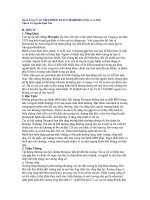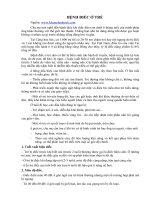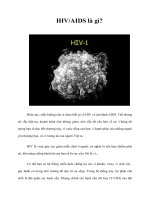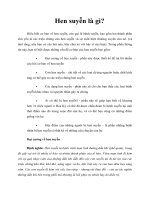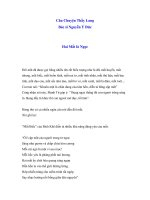Tài liệu Soul Talk, Song Language pdf
Bạn đang xem bản rút gọn của tài liệu. Xem và tải ngay bản đầy đủ của tài liệu tại đây (4.09 MB, 159 trang )
Soul Talk,
Song Language!@
Soul Talk,
Song Language
Conversations with Joy Harjo
Joy Harjo and Tanaya Winder
Photographs by Joy Harjo
wesleyan university press
middletown, connecticut
Wesleyan University Press
Middletown CT 06459
www.wesleyan.edu/wespress
© 2011 Joy Harjo and Tanaya Winder
All rights reserved
Manufactured in the United States of America
Designed by Katherine B. Kimball
Typeset in Sabon by Alice W. Bennett
5 4 3 2 1
Wesleyan University Press is a member of the Green Press Initiative.
The paper used in this book meets their minimum requirement
for recycled paper.
Library of Congress Cataloging-in-Publication Data
Harjo, Joy.
Soul talk, song language : conversations with Joy Harjo / Joy
Harjo and Tanaya Winder ; photographs by Joy Harjo.
p. cm.
isbn 978-0-8195-7150-2 (cloth : alk. paper) —
isbn 978-0-8195-7151-9 (e-book)
1. Harjo, Joy—Interviews. 2. Indian authors—Interviews.
3. Indians in literature. 4. Indians of North America—Ethnic identity.
I. Winder, Tanaya. II. Title.
ps3558.a62423z46 2011
811.54—dc22 2011021768
frontispiece: “Earth Breathing.”
© Joy Harjo
Contents
Foreword: A Carrier of Memory | ix
Laura Coltelli
Acknowledgments | xvii
I. Interviews
Becoming the Thing Itself | 3
Interview with Triplopia
Music, Poetry, and Stories: Returning to the Root Source | 27
Interview with Rebecca Seiferle
Exploring the Depths of Creation and Meaning | 31
Interview with Simmons Buntin
The Thirst for Artistic Brilliance | 38
Interview with Pam Kingsbury
In the Horizon of Light with Joy Harjo | 46
Interview with Ruben Quesada
Writing, Constructing the Next World | 50
Interview with Bill Nevins
Transcending Writing on Singing Wings | 54
Interview with Tanaya Winder
vi Contents
Song Language: Creating from the Heart, Out | 61
Interview with Loriene Roy
You Might as Well Dance | 68
Interview with Harbour Winn, Elaine Smokewood, and John McBryde
The Craft of Soul Talk | 78
Interview with Susan Thornton Hobby
II. Columns by Joy Harjo
Global Roots | 87
Muscogee Nation News, October 2006
Identity | 90
Muscogee Nation News, December 2006
Censorship and the Power of Images | 93
Muscogee Nation News, May 2007
It’s Difficult Enough to Be Human | 97
Muscogee Nation News, June 2007
Dehumanization Flatlines | 101
Muscogee Nation News, August 2007
We Are Story Gatherers | 104
Muscogee Nation News, June 2008
We Are the Earth | 106
Muscogee Nation News, August 2009
A Way to Speak Their Souls | 108
Muscogee Nation News, February 2010
Energy of the Transaction | 110
Muscogee Nation News, April 2010
Contents vii
Watching the World Shift | 112
Muscogee Nation News, July 2010
III. The Last Word: Prose Pieces by Joy Harjo
Preface for She Had Some Horses | 121
From the second edition, W.W. Norton, 2009
The Art of Resistance | 123
Preface for Indigenous People’s Journal of Law, Culture and Resistance, 2004
Afterword for The Delicacy and Strength of Lace | 127
From the second edition, Graywolf Press, 2009
In Honor of Patricia Grace | 129
World Literature Today, May–June 2009
I Used to Think a Poem Could Become a Flower | 133
Introduction to Ploughshares, December 2004
Talking with the Sun | 135
From This I Believe, July 2007
This page intentionally left blank
Foreword
A Carrier of Memory
laura coltelli
In this volume of interviews and collected writings, Joy Harjo acts as
a guide, taking us on a journey into her identity as a woman and as
an artist, poised between poetry and music, encompassing tribal heri-
tage, productive reassessments, and comparisons with the American
cultural patrimony. But even before presenting herself in an exquisitely
literary context, she proudly underlines her Indian roots, and this all-
embracing assertion unceasingly leaves a profoundly coherent mark
on form and content. Thus these interviews accompany the reader on
a human and professional itinerary, where the reading of her poems
is often an illuminating exegetic commentary, directly or more often
perceptibly, but at the same time it speaks of the place and time where
her inspiration was born.
From the very beginning, it communicates a cultural background
that draws on family habits—painting and music—the former from her
grandmother Naomi Harjo and her great-aunt Lois Harjo (“I found a
great refuge in the act of drawing”), the latter from her mother (“my
mother was a singer, so we had music and her voice often holding our
home together”), up to the moment of her escape from Oklahoma to
New Mexico to study at the Institute of American Indian Arts (IAIA),
and subsequently at the University of Iowa. Her initial relationship
with this university was problematic, due to the quality of its teaching
(“too male and white oriented”) and the gap between her educational
background and that of other students, in an environment where the
artistic sensibility included nothing of her tribal tradition (“I felt a
stranger there”). But the strength of her inner world, her great creative
inspiration, although “married with great despair” as a result of a pain-
ful sense of discomfort and harsh everyday difficulties, nevertheless
projected her toward increasing acquirement of her means of expres-
x Foreword
sion. Her success as a poet, after a relatively short period of writing,
is displayed in numerous volumes. Her work is attracting a growing
readership, and has drawn the attention of critics in the United States
and elsewhere, as well as in several university courses dedicated to her
production, giving rise to high-quality degree dissertations.
In this collection of interviews there unfolds a detailed discussion
of the complex material from which she derives her inspiration, a tes-
timony that points to a relentless drive toward the truth in the many
worlds that she passes through, always animated by the desire to find
an area of light, sometimes in a harsh clash with reality. But the first
thing to emerge from her writer’s laboratory is the close anchoring
of her poetry to orality, with the result that “written text is, for me,
fixed orality”: it thus goes back to a performance she remembers and
it transmits an oral act, in which the moment of speaking and listening
unites the poet and her audience in a single inseparable unit. Hence
the creation of a mixed genre, or cross-genre writing, is increasingly
present in her more recent works. These are compositions from which
several voices emerge—poems, prose poems, stories, commentaries
preceding the poems, which are generally created “to mimic oral pre-
sentations,” or as a reflection of an oral experience of poetry. In the
answers that Harjo gives, this concept is often repeated, and from this,
in turn, there emerges music as a natural continuity, not so much as
a bridge between two genres, but because “the roots of poetry lead
to music.” Since poetry is a sound art, as she affirms, music, singing
voice, and spoken poetic word converge together “as one voice.”
Music, and in particular that of the saxophone, to which she has
turned her hand in recent years, is often mentioned in these interviews.
Besides speaking of a beloved Indian ancestor who played the same
instrument, of her band, or of individual musicians like Larry Mitch-
ell, with whom she often performs, she specifies that by so doing,
she creates a performance in which she challenges the current way of
interpreting the utilization of poetry: indeed “That was the original
impetus of the poetry, and of the sax, to find a way to sing: I still want
my poems to stand up on their own. This will make me even more a
maverick in the poetry world, in this country at least. I don’t enjoy
academic reverie.”
Thus Harjo’s work now includes aspects different from those that
Foreword xi
it displayed initially: the written word also becomes a voice modu-
lated with traditional tones—songs and chants, which radiate a music
that springs from her saxophone. But the sonorities that come into
being are not an accompaniment or a musical tempo, but rather inti-
mate unions of words, voices, and sounds which convey the blend and
interpenetration of meanings and rhythms, perfectly harmonized in a
continual reciprocal reflection. A performance like this goes beyond its
own communicative act, and becomes the expression of a culture, as
she says, captured in its deepest roots, and modulated with a sense of
belonging and continuity. The contribution of modern sonorities such
as blues is suggestive not so much of influences, but of a revitaliza-
tion of a kind of music born and cultivated in the tribal environment.
This is the awareness that animates the poetics and musical activity of
Joy Harjo, intent as she is on not leaving any empty spaces between
words, voice, and music.
The answers to the various interviewers depict a world in which
the things of life emerge and are transmitted by an energy that unites
people, plants, and animals, “an engagement and not a dominant con-
cept” but something “that opens everything up.” Her poetic expres-
sion, thus interpreted, allows her “to speak directly in a language that
was intended to destroy us” or, to quote another famous text of hers
on Native American women writers, edited with Gloria Bird, “rein-
venting the enemy’s language.” It is a language at the basis of so-called
“minority literature”—Indian, in this case—a label that Harjo identi-
fies as a “power trick” because, she affirms, the geographic expanse of
tribal cultures covers an immense extension from one end of the globe
to the other, including major literary traditions: “It’s the fearful ones
who try and keep us out who are still looking for a place.” And she
goes on: “This ‘American culture’ is young and rootless. It is adoles-
cent with an adolescent sense of time and place, that is ‘here and now,’
with no reference or power rooted in the earth, ancestors, or historical
and mythical sense. Value your community and what that has to offer,
and continue to reach out beyond what you know, and grow fresh
ideas, meetings between borders, new roots.”
This continual aspiration to an inner growth, the need for a dia-
logue with the multiple heritage of the past, with everything that
moves around human beings, in the contrast that arises with contem-
xii Foreword
porary America, is summed up in another highly perceptive affirma-
tion regarding the mainstream culture of the United States:
I have always called the U.S. culture the “over-culture” and don’t con-
sider it a true culture. Belief, social institutions, art, and traditions con-
struct culture. The United States is made up of many cultures. There is no
such thing as a melting pot. There are various cultural streams that are
renewed, slowed, cut off, or otherwise changed. The over-culture is a cul-
ture of buying and selling.
Furthermore, this bitter appraisal pervades her awareness of tragic
events in contemporary America, besieged by violence and imperialis-
tic forays which in the end provoke further violence at the heart of its
own territory: its onset may appear to be sudden, “but there is a trail
that goes back, like roots.” And these are the same roots that go back
to the distant past, that is to say, almost as far back as the ethnocide of
the tribal peoples. This is a reflection that brings with it the landscape
of the American West, full of history and wounds, and at the same
time remembered and celebrated as an “intimate connection,” lands
which have nourished a never-ending journey, together with the land-
scape of Hawai‘i, where Harjo lived for many years, “to learn water”;
“when water is the prevailing influence everything in the atmosphere
carried its essence of being.”
The representation of Harjo’s activity extends to the role and the
responsibility of artists: they must bring a testimony of experience in
the present, but also a renewal in the wake of tradition; they promote
and regenerate art and culture, sometimes communicating with their
public almost beyond the realm of words, if the communicative act
takes place in perfect reciprocal integrity, if words are used to usher
in transformation. In this context, then, to write poetry “is to move
into the world and effect change,” and that includes artists and their
public, both part of the poem.
Starting from these premises, Joy Harjo describes why she wrote
two children’s books (The Good Luck Cat and For a Girl Becom-
ing), not just to mark the birth of her grandchildren, but above all
to cement relationships and responsibilities, to inspire an intimately
reciprocal sense, to make sure that “all children are able to see them-
Foreword xiii
selves in each other,” “to re-imagine themselves as beautiful and pow-
erful . . . moved to dream and share.” All this derives from consider-
ing that her generation was taught to read by the Dick and Jane series,
in which, rather than being created for children, the stories described
an orderly, aseptic social reality, closed to everything that was not a
part of the mainstream way of life, the same primer so perspicaciously
described and progressively altered by Toni Morrison in The Bluest
Eye.
Although different in its aims and functions, Joy Harjo’s teaching
experience—she has several times held courses of creative writing at
prestigious universities—is based on the same principles: “Study with
all parts of your being, not just your intellect. Some of your knowledge
may come from books, most of it from other sources.” Such teaching
transcends the formal techniques, always leading to an interrelation
of all things, from which knowledge and true understanding are born.
Bearing in mind the frequently mentioned sense of reciprocity, this
teaching experience “can feed the writing,” “unless you are involved
in academic politics and fights.”
On other battles, Joy Harjo as a woman does not fail to speak
her mind, expressing appreciation for the achievements of feminism,
which has undoubtedly inspired significant changes, though many of
these aspirations do not accord with the organization of the tribal
world. However, in our modern-day world, she adds, we are still sur-
rounded by a system in which everything connected with female expe-
rience is underestimated. Starting from its conception of the world,
Christianity cancels every female presence, whereas there can be no
creative power without any female force.
In her articles for the Muscogee Nation News, she almost always
starts by watching what is happening in the natural world. This view,
with its inner harmony, clashes with what she sees in our society: ste-
reotyped images of Indians, identity issues, fabricated or false stories
giving rise to festivities like Thanksgiving, Hollywood movies about
Native tribes, or the dehumanized way of living in a society where
massacres and racism are the inexorable outcomes. Harjo’s thoughts
turn instead to global roots and ancient trades by which almost every-
thing traveled all over the world, connecting peoples and cultures. The
same can be said for our creation of our own stories, which means that
xiv Foreword
we pass on family, clan, and tribal knowledge from one generation to
another, making time and space larger than we can imagine.
In the six pieces with which the volume closes the poet merges with
the witness, not only of her times, but also of the past, conserving a
moral and historical legacy engraved in her memory. The common
denominator is an act of resistance as a safeguard against the wounds
inflicted on the earth, to defend what a person is—although consid-
ered in various ways inferior because he or she does not fit neatly
into the mold of civilization. By the same token, then, the term ‘act
of resistance’ can also be used for the work of Patricia Grace, who
was celebrated by Harjo when she was awarded the Neustadt Inter-
national Prize for Literature. Grace is considered to be an ambassador
for Maori writing and culture; her stories mingle her tradition with
Western forms of contemporary literature. This is a way for all tribal
cultures to remain anchored to the past, while renewing their tradition.
And lastly there is the critic who skillfully enters into the intimate
communicative process of epistolary literature in her afterword for
The Delicacy and Strength of Lace, with the same “delicacy” that can
be found in this exchange of letters between James Wright and Leslie
Marmon Silko. Harjo detects, in the words of both, all the painful
implications, or the peaceful flow of ordinary daily life, marked by
sounds and colors that softly illuminate moments that may appear to
be common, but which enclose inside them the savor of deep knowl-
edge and the tranquil beauty of everything that surrounds us. It is a
union of poetry and storytelling, says Harjo, and of human and liter-
ary voices which meet and share this interlaced pattern. Harjo, an art-
ist herself, enters into this kind of creative laboratory, recognizing “the
struggle to be artists in the midst of the daily challenges of living.”
But being a poet is also a challenge that expands, in order to recon-
struct this land called America. With the strength of writing, of poetry,
of myths, it is possible to lay the foundations for a change, and to
penetrate with language a spiral of cognitive experience, the essence
that genuinely gives meaning to the life of our intellect and our spirit.
This is a concept of poetic art where there is no place for higher forms
of poetry that descend from the European tradition, as has already
been repeated in various interviews. Beyond every hierarchy of value,
poetry interprets and consigns to us the world to which we belong,
Foreword xv
always looking for vision, as when Harjo goes out in search of a
glimpse of sky early in the morning, above the neon totem poles in
Times Square, to present her four-day-old fourth granddaughter to the
sun: the affirmation of a harmonious relationship, the celebration of a
sacred commission that gives certainty to our life. Like the sun, above
the rain in New York. Like poetry. “The Last Word.”
What emerges as a distinctive characteristic from this wide-ranging,
insightful series of interviews is a constant boundary-crossing: vari-
eties of genres, which are however linked together in a precise cog-
nitive itinerary; the blending of the oral and the written to inform
each other; the poetic sound of words and the sound of the sax; the
woman and the artist telling of a perfect osmosis between life and
writing; the water of Hawai‘i and the New Mexico desert; a pervasive
call-and-response that Harjo always seeks from her audience. In these
detailed responses, Harjo weaves a tapestry where every strand evokes
a further pattern. It’s a dynamic process which continually opens up
new possibilities of knowledge and artistic experimentation. And it
is the testimony of a generous, fully convinced commitment which
brings the past and the culture of her people to life with all the incisive
mastery of modern means of expression, yet constantly draws on the
strength of a memory, experienced not as an inert instrument, but as a
driving power in the definition of an identity and in its affirmation in
contemporary America.
Joy Harjo lives in many different worlds, and by means of these
interviews, she not only allows us to enter into her creative laboratory
but she also draws a moving geography of the soul, a sort of irregular
autobiography that possesses an extraordinary narrative effectiveness.
The reader perceives that she is always intensely dedicated to reach-
ing, or recovering, intangible perfections or visions in her search as a
woman and an artist.
Laura Coltelli is a professor of American literature at the University of Pisa, Italy. Her publications
include Winged Words: American Indian Writers Speak (1990) and an edited collection of essays,
Reading Leslie Marmon Silko.
This page intentionally left blank
Acknowledgments
My gratitude with singing and some saxophone riffs to Suzanna
Tamminen for her enthusiasm and belief in this project; to Stephanie
Elliot for her support and encouragement; to LeAnne Fields for urging
the project on; mvto to Becca Landsberry, Ruth Bible, and the rest of
the Muscogee Nation News staff for their assistance; to Laura Coltelli
for discernment, friendship, and the impeccable introduction; to Tanaya
Winder for her assistance, precise words and thoughts; and—for my
poetry, writing, and music ancestors and descendants—mvto, mvto.
“Exploring the Depths of Creation and Meaning” originally appeared
in Terrain.org: A Journal of the Built & Natural Environments, Sep-
tember 10, 2006. “You Might As Well Dance” was originally pub-
lished in the winter 2008 issue of Humanities INTERVIEW; reprinted
with permission of the Oklahoma Humanities Council. “The Craft of
Soul Talk” is reprinted by permission of the Howard County Poetry
and Literature Society, www.hocopolitso.org, and the Little Patuxent
Review, www.littlepatuxentreview.org.
“Preface for She Had Some Horses” is used by permission of
W. W. Norton & Company, Inc. “Afterword from The Delicacy and
Strength of Lace” is reprinted with permission of Graywolf Press,
Minneapolis, Minnesota, www.graywolfpress.org, from The Delicacy
and Strength of Lace: Letters Between Leslie Marmon Silko and James
Wright, edited by Anne Wright. “In Honor of Patricia Grace” was first
published in World Literature Today 83.3 (May–June 2009): 34–36;
reprinted by permission. “I Used to Think a Poem Could Become a
Flower” originally appeared in Ploughshares, December 2004.
Grateful acknowledgment is also made to the following: Triplo-
pia, The Drunken Boat, Southern Scribe, El Molino Press, albuquer-
queARTS, Multicultural Review, and UCLA’s Indigenous People’s
Journal of Law, Culture and Resistance.
“Breakthrough over Michigan Dunes.” © Joy Harjo
!@
i
Interviews
This page intentionally left blank
!@
Becoming the Thing Itself
[Interview with Triplopia, 2005]
Joy Harjo knows noise.
Explore her writing and you’ll soon find it rich in the auditory
imagery of dogs barking, the ground speaking, and the moon playing
the horn. And yet, sounds do much more than play to the senses in
Harjo’s poetry.
I was first introduced to Harjo’s voice through her poem, “She Had
Some Horses,” in Lucille Clifton’s poetry class. By a careful reading of
the poem, Clifton managed to guide her undergraduates through the
repetition of the poem, the horse-running composition found in the
rhythms of the words, and the end line which reverberated within us.
“There is music here,” Clifton suggested, and indeed there was.
Joy Harjo knows noise.
Harjo has won many accolades and awards for her writing, includ-
ing the William Carlos Williams Award, the American Indian Distin-
guished Achievement in the Arts Award, the Josephine Miles Poetry
Award, the Mountains and Plains Booksellers Award. She has won
fellowships from the National Endowment for the Arts, the Arizona
Commission on the Arts, and the Witter Bynner Foundation. She
holds a B.A. from the University of New Mexico, an M.F.A. from
the University of Iowa, and an honorary doctorate from Benedictine
College. In 2003–2004, she won dual awards, Writer of the Year and
Storyteller of the Year from Wordcraft Circle of Native Writers and
Storytellers for her book, How We Became Human: New and Selected
Poems 1975–2001, and her CD, Native Joy for Real. Most recently,
Wordcraft Circle awarded her the title of 2005 Writer of the Year—
Film Script, for A Thousand Roads, which she wrote for the National
Museum of the Native American.
4 interviews
She is an artist in more ways than one, as she is poet, songwriter,
screenwriter, children’s writer, musician, and storyteller. And yet for all
of her degrees, awards and accolades, she still runs across those who
do not feel her writing is considered poetry.
Joy Harjo knows noise.
We recently had the privilege of catching up with Joy when we dis-
cussed the fusion of oral and written poetry, the responsibility of the
poet, and the way music penetrates us all . . . .
You started out painting, yes?
Yes, I started out painting when I was young and often think about
returning to it. I never quite developed it. I eventually leaped over to
poetry.
And now you’ve been working with music for quite some time, as well
as screenplays.
Music was probably my first love, but I didn’t start working on it until
the last fifteen years or so. I’ve written prose, and in fact, have a book
way overdue at Norton. The contract is for a memoir, but memoir
sounds so pretentious to me. It’s actually a book of stories, some of
it as memoir. At the moment I’m working on a show, something that
will combine all of the above. And yes, screenplays, too. A screenplay
I cowrote for the National Museum of the American Indian, A Thou-
sand Roads, just premiered at Sundance.
There’s a 1993 interview with Marilyn Kallet, in which Kallet asks if
you regretted the decision to give up painting, and asked what poetry
could do that painting couldn’t, and you answered that it allows you
to “Speak directly in a language that was meant to destroy us.” Do
you find yourself attracted to that particular challenge?
As an artist, I don’t really think about all that—being interviewed also
engages the creative. You know, you have to come up with answers for
interviewers. [laugh] But yeah, you do it because it absolutely moves
you. What attracted me to poetry was language, was basically sound.
Poetry is a sound art. Oral poetry is experienced directly as sound
art. Poetry in books is sound art but for the most part has lost the
original link to performance. Now performance poetry has become a
Becoming the Thing Itself 5
pejorative term. Poetry was here long before Mr. Gutenberg, scrolls,
or any other book-like means of transporting the word. What enticed
me about poetry was being able to hold in my hands and in my heart
these small pieces of meticulous and beautiful meaning. It was like
reclaiming the soul, or giving the soul a voice.
When you talk about your first encounter with music, you describe it
as being drawn into the music on an almost physical level. There are
a lot of other instances in which memory seems to be accompanied by
the same mixing of senses. Is this part of the process for you?
I guess so. I don’t like to think about it too much. You know? [laugh]
Because when I start thinking too much, it gets in the way and some-
times even just writing what I have to do is like going through a ritual
to get rid of all the literal and linear and hierarchical stuff of the West-
ern world, and I have to just let that go. My first experience of music
in this world was through my mother’s singing voice. I have a very,
very faint memory of that experience while in the womb, and then
it became the center of my world, especially in the formative years,
when my mother was writing songs and singing for country swing
bands, jukeboxes in truck stops where she worked, the radio, guitar
players at the house. Music was and is my body. I don’t think I ever
felt a separation between music and my body. Words make bridges but
music penetrates.
In reading your poetry, I find myself immediately thinking in terms of
dynamicism.
Yes, that appears to be the consensus. I’ve collaborated with an as-
tronomer, Stephen Strom: his photographs, my poetic prose pieces.
His astronomical study is on the birth of stars. Poetry also concerns
rigorous studies, of the human soul, which is directly connected to
Strom’s studies. We all appear to struggle in this universe. Poetry is
basically another discipline and provides a structure for understand-
ing the world. Science is a religion. Its world is mechanistic. Some
philosophical strands of American and European poetry are similar,
based on a mechanistic world, and more theoretical. To dip down into
the soul is to get dirty. The more theoretical, the more removed it can
become, and then you lose a relationship between the soul and the
6 interviews
world. You talk at it rather than move with it. I’ll never forget my first
day of teaching at the University of Colorado, Boulder. Reg Saner was
a professor there. He introduced himself and came into my office. Said
that he believed there were two kinds of poets; he called them Jacob
and Esau poets, Jacob implying the refined and Esau the hairy wild
man. He considered me of the second sort, primitive. Seems to me this
becomes a pejorative kind of naming though he may not have meant
it directly that way. The way I took it at that time was as a question:
what is such a primitive poet doing in such a refined place?
And that connection between the soul and the world is important to
you in your poetry?
To me, that’s what poetry is. The communication with the soul is im -
portant to me, and maybe this, too, is considered primitive!
There’s communication going on here.
Right.
In a couple of previous interviews, you’ve mentioned the idea of the
fusion of oral and written as a new literature. How do you see this
manifesting itself in your work?
Well, I think it is on Native Joy for Real. I consider singing, the sax-
ophone, and poetry the blending of the oral and written. My early
poems were short, lyrical statements usually fastened around one
image. Then, they grew as my concept of poetry and vision grew.
Being a mother of young children influenced the form. Then as the
children grew, so did spaces of time in which to write. The lines grew
longer, the vision deeper. The first experimentation I did with the in-
terweaving of the oral with written was in The Woman Who Fell From
the Sky. By the time I got those poems, I was trying to figure out how
to make a book reflect an oral experience of poetry, in written form.
Hence, the prose pieces in between the poems. They were another
kind of experience that replicated, I felt, the experience of the per-
formance of the poems. It’s not the first time it was done. Evers’ and
Molina’s Yaqui Deer Songs used this technique, and they referred to
Leslie Silko’s Storyteller. I wanted the experience of the book to mimic
my oral presentations, which often have commentary preceding the


